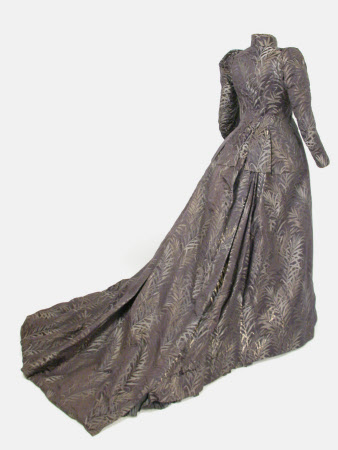Afternoon dress bodice
Peter Robinson Mourning Warehouse
Category
Costume
Date
1889
Materials
Silk, linen, lead, iron, copper alloy, wool, baleen
Measurements
660 mm (Length)840 mm (W)740 mm (W)620 mm (Length)
Place of origin
Regent Street
Order this imageCollection
Killerton, Devon
NT 1363090.1
Summary
Part of a two piece afternoon dress of black silk figured with silvery cream and grey willow leaf design. Bodice; Cuirasse-style with short stand-up collar with net underfrill, with twenty three silk covered spherical metal buttons (one missing) to front opening, false lapels, pointed waistline, four basque tabs to back; coat sleeves with fullness gathered at elbow, slit cuffs with six buttons and pleated net underfrill. Black silk facings, brown twill lining, boned, basques weighted (one weight missing) Made by Peter Robinson Mourning Warehouse, Regent Street (woven in waistband). 1889 (circa)
Provenance
Acquired by the National Trust in 1986 from Nancy Bradfield, author and illustrator of books relating to English Costume. Displayed by the National Trust at Killerton in 1987, 1991, 1996 and 2008. Worn by Florence Woolward (1854-1936) an English botanical illustrator and author. Florence moved to Belton village as a young girl and grew up in the Rectory there. Her father was a Rector and domestic chaplain for Earl Brownlow of Belton. As a teenager, Florence showed an early aptitude for painting and, with access to Belton’s garden and Pleasure Grounds, she captured the landscapes and plants that she saw around her. Self-taught, she developed an incredible eye for detail, reinforced by a detailed knowledge of plants that she gained from her parents. It is thought that the Brownlow family brought Florence’s painting talents to the attention of the 9th Marquess of Lothian. He housed a huge collection of orchids at his family home of Newbattle Abbey. Impressed by her talent the Marquess commissioned Florence to create a visual record of his orchid collection. This was published in parts between 1891 and 1896 as "The Genus Masdevallia". The dress was passed to Nancy Bradfield by Miss Evelyn Joan Woolward, great niece of Florence Woolward, in 1973.
Makers and roles
Peter Robinson Mourning Warehouse, maker

